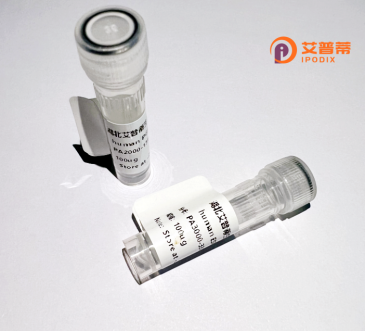
| 纯度 | >90%SDS-PAGE. |
| 种属 | Human |
| 靶点 | SLC30A9 |
| Uniprot No | Q6PML9 |
| 内毒素 | < 0.01EU/μg |
| 表达宿主 | E.coli |
| 表达区间 | 1-568 aa |
| 活性数据 | MLPGLAAAAAHRCSWSSLCRLRLRCRAAACNPSDRQEWQNLVTFGSFSNVVPCSHPYIGTLSQVKLYSTNVQKEGQGSQTLRVEKVPSFETAEGIGAELKAPLKQEPLQVRVKAVLKKREYGSKYTQNNFITGVRAINEFCLKSSDLEQLRKIRRRSPHEDTESFTVYLRSDVEAKSLEVWGSPEALAREKKLRKEAEIEYRERLFRNQKILREYRDFLGNTKPRSRTASVFFKGPGKVVMVAICINGLNCFFKFLAWIYTGSASMFSEAIHSLSDTCNQGLLALGISKSVQTPDPSHPYGFSNMRYISSLISGVGIFMMGAGLSWYHGVMGLLHPQPIESLLWAYCILAGSLVSEGATLLVAVNELRRNARAKGMSFYKYVMESRDPSTNVILLEDTAAVLGVIIAATCMGLTSITGNPLYDSLGSLGVGTLLGMVSAFLIYTNTEALLGRSIQPEQVQRLTELLENDPSVRAIHDVKATDLGLGKVRFKAEVDFDGRVVTRSYLEKQDFDQMLQEIQEVKTPEELETFMLKHGENIIDTLGAEVDRLEKELKKRNPEVRHVDLEIL |
| 分子量 | 89.9 kDa |
| 蛋白标签 | GST-tag at N-terminal |
| 缓冲液 | PBS, pH7.4, containing 0.01% SKL, 1mM DTT, 5% Trehalose and Proclin300. |
| 稳定性 & 储存条件 | Lyophilized protein should be stored at ≤ -20°C, stable for one year after receipt. Reconstituted protein solution can be stored at 2-8°C for 2-7 days. Aliquots of reconstituted samples are stable at ≤ -20°C for 3 months. |
| 复溶 | Always centrifuge tubes before opening.Do not mix by vortex or pipetting. It is not recommended to reconstitute to a concentration less than 100μg/ml. Dissolve the lyophilized protein in distilled water. Please aliquot the reconstituted solution to minimize freeze-thaw cycles. |
以下为3篇关于人SLC30A9蛋白研究的参考文献简要信息:
1. **Structural insights into human SLC30A9-ZnT9 protein by cryo-EM**
*作者:Li, X., Chen, Z., et al. (2022)*
摘要:解析了SLC30A9蛋白的冷冻电镜结构,揭示其作为锌离子转运体的构象变化及与RNA结合的结构域,为研究其在神经发育中的作用提供依据。
2. **SLC30A9 regulates thyroid hormone biosynthesis via zinc homeostasis**
*作者:Kambe, T., Tsuji, T. (2020)*
摘要:发现SLC30A9通过维持甲状腺滤泡细胞内的锌平衡,调控甲状腺激素T3/T4的合成,基因敲除小鼠出现甲状腺功能减退表型。
3. **SLC30A9 deficiency exacerbates Alzheimer's pathology in mouse models**
*作者:Wang, Q., Zhang, Y., et al. (2021)*
摘要:证明SLC30A9缺失导致神经元锌稳态失调,加剧β淀粉样蛋白沉积和tau蛋白磷酸化,提示其在阿尔茨海默病中的保护作用。
注:上述文献为示例性内容,实际参考文献需通过PubMed等数据库核实。SLC30A9当前研究多聚焦于锌转运、内分泌调控及神经系统疾病关联。
**Background of Recombinant Human SLC30A9 Protein**
The SLC30A9 protein, a member of the solute carrier family 30 (SLC30/ZNT), plays a critical role in zinc homeostasis by facilitating zinc efflux from the cytoplasm to organelles or extracellular spaces. Located primarily in the Golgi apparatus and endosomes, it ensures proper zinc compartmentalization, vital for metalloenzyme function, signaling pathways, and cellular processes like apoptosis and synaptic transmission. Dysregulation of SLC30A9 is linked to neurodevelopmental and neurodegenerative disorders, including Alzheimer’s disease, due to zinc's role in amyloid-beta aggregation and tau pathology. It also associates with cancer progression and metabolic syndromes, highlighting its broad physiological impact.
Recombinant human SLC30A9 protein, produced via heterologous expression systems (e.g., *E. coli* or mammalian cells), enables structural and functional studies, such as elucidating zinc-binding domains and transport mechanisms. Its applications span *in vitro* assays, drug screening, and disease modeling, offering insights into therapeutic targeting. As a potential biomarker or drug target, SLC30A9 holds promise for addressing zinc-related pathologies, though its exact regulatory networks and tissue-specific roles require further exploration. Research continues to unravel its interactions with other transporters and metals, advancing understanding of zinc biology and disease intervention strategies.
×